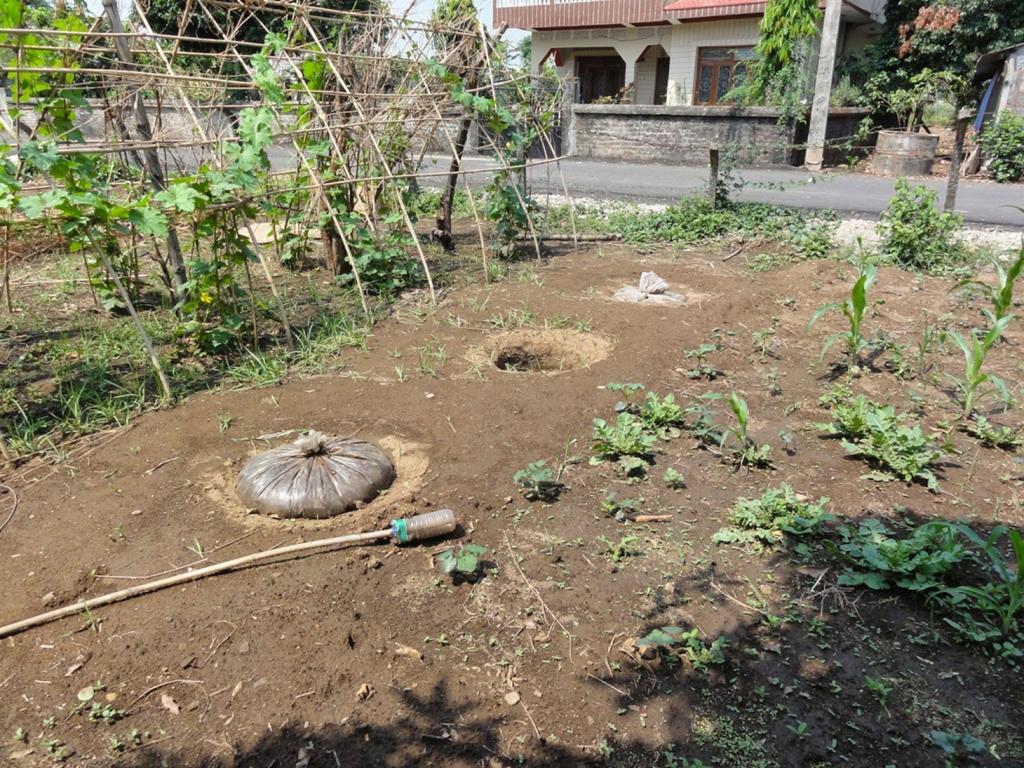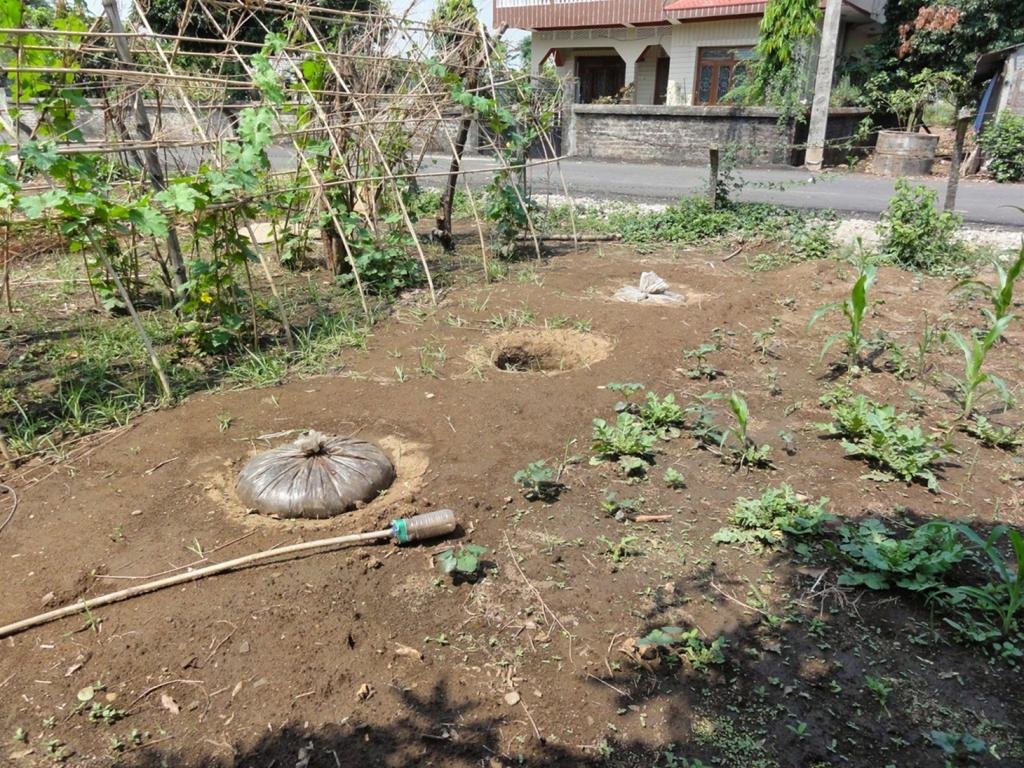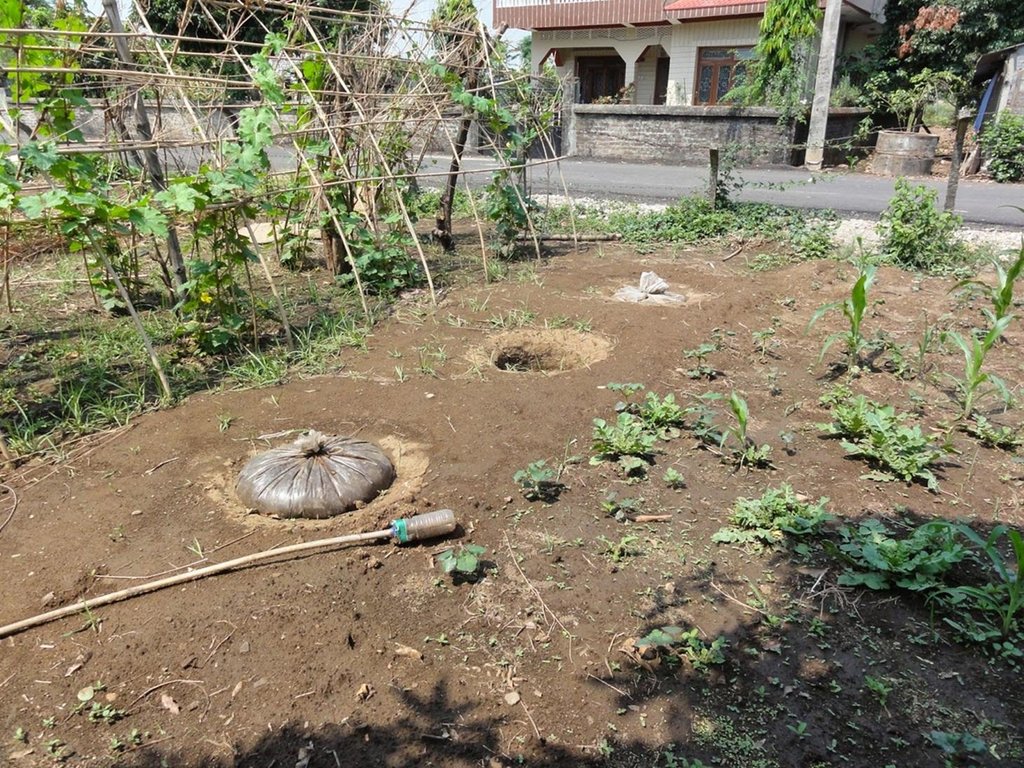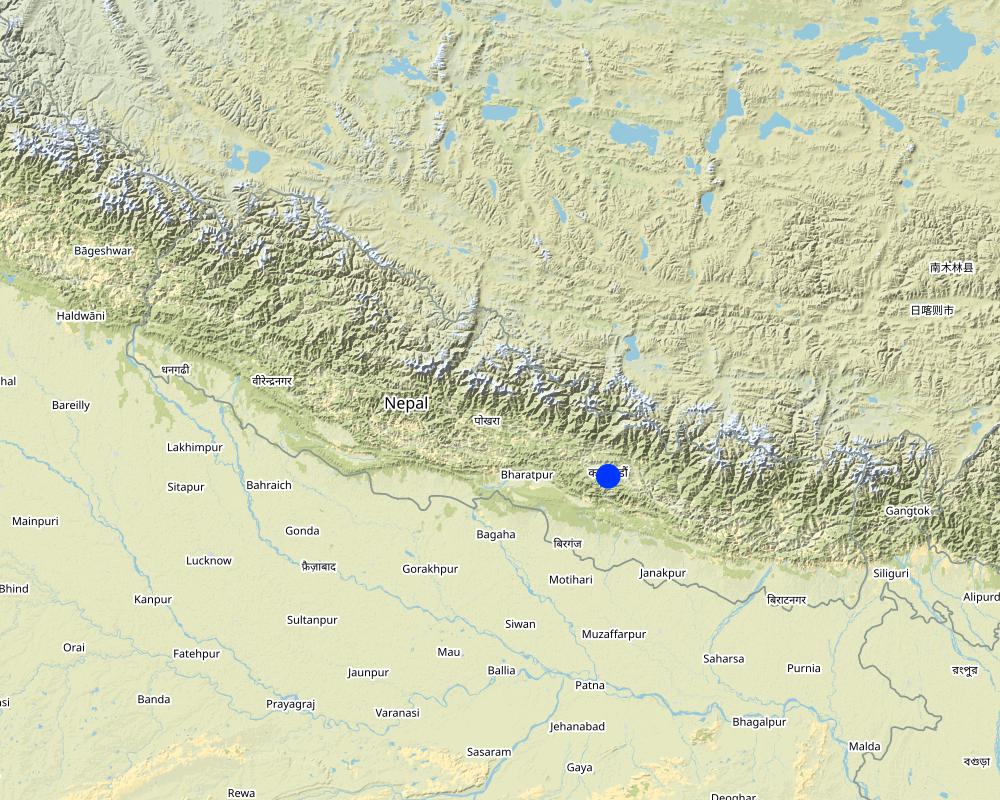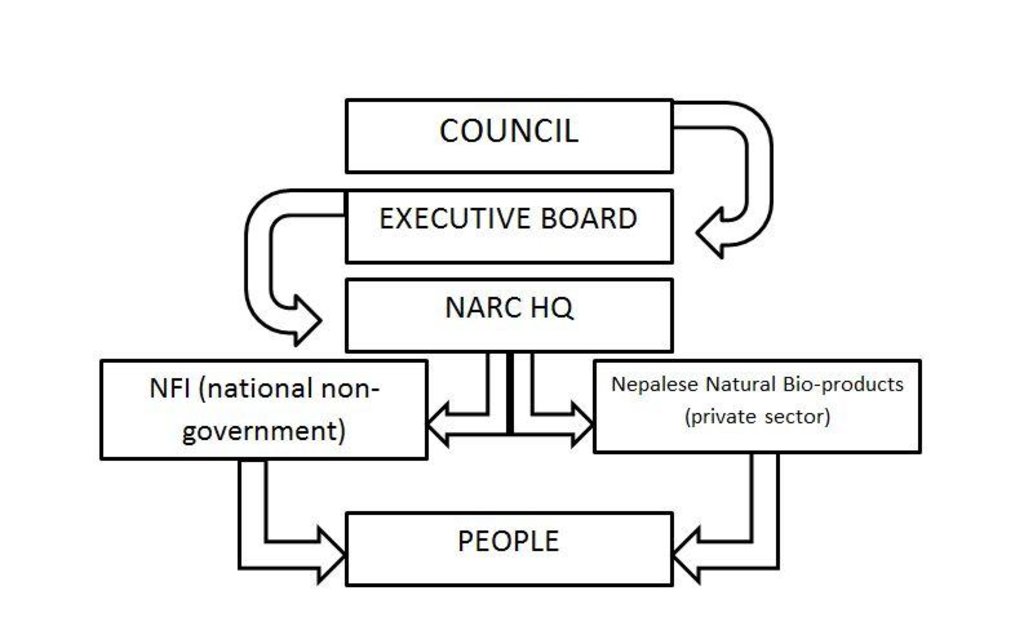Benefits of Jeevatu in crop production and protection [Nepal]
- Creation:
- Update:
- Compiler: Sabita Aryal
- Editor: –
- Reviewers: Fabian Ottiger, Joana Eichenberger
Jevatu
approaches_2484 - Nepal
View sections
Expand all Collapse all1. General information
1.2 Contact details of resource persons and institutions involved in the assessment and documentation of the Approach
SLM specialist:
Sherpa . C Tenzing
Kathmandu University
Kavre, Nepal
Nepal
SLM specialist:
Pradhan Ozal
Kathmandu University
Kavre, Nepal
Nepal
SLM specialist:
Poudyal Bharat Kumar
Central Vegetation seed production center
Nepal
Name of the institution(s) which facilitated the documentation/ evaluation of the Approach (if relevant)
Kathmandu University (KU) - Nepal1.3 Conditions regarding the use of data documented through WOCAT
When were the data compiled (in the field)?
22/09/2011
The compiler and key resource person(s) accept the conditions regarding the use of data documented through WOCAT:
Yes
2. Description of the SLM Approach
2.1 Short description of the Approach
Beneficial uses of Jeevatu in crop production and protection.
2.2 Detailed description of the Approach
Detailed description of the Approach:
Aims / objectives: The use of Jeevatu has been and still is solely for agricultural purpose. The main objective of it is to effectively free the environment different poisonous chemicals that are present in the form of pesticides and fertilizers.
It aims to prevent and control pests and diseases, including bacterial, viral and fungal, in vegetables, cereals, flowers and fruit trees, and to improve the growth of the plant, the yield and the quality of the fruits (vitamin content and peel thickness).
It can also be used to keep different fruits and vegetables fresh for a longer period of time.
Jeevatu further helps by promoting the proper management of the waste materials as the key ingredient in the process of producing Jeevatu is different organic wastes.
It provides an advantage to the farmers by an economic point of view as well - the cost of Jeevatu is comparatively much less than that of other pesticides and fertilizers.
Methods: A 2 feet wide and 1 foot long pit is dug in a fertile land.
A plastic sheet is placed in the pit
Raw cow dung and water is poured in the pit and made greasy
The 1m25cm plastic sheet is then made air and water tight by tying it up with a jute rope
Every 2-3 days water is added and the mixture is stirred well
The water added amounts up to about 50L.
After 17-25 days , a green colour is seen in the outer surface of the plastic bag and the odor is no longer present, this indicates that the fertilizer (Jeevatu) is now ready to be used.
The plastic bag is then removed and a new plastic sheet is placed to start the production of a new batch of Jeevatu
1L of the previous made Jeevatu is also included to after the second batch to gain a better yield of Jeevatu.
Role of stakeholders: There are mainly two types
The producers-
They seek profit in terms of money as they plan to produce good amounts of Jeevatu and sell them to the people involved in agriculture or animal husbandry
The people involved in agriculture and animal husbandry-
They seek profit in terms of good yield of crops or animal products. The use of Jeevatu benefits them and keeps them as well as the environment safe.
2.3 Photos of the Approach
2.5 Country/ region/ locations where the Approach has been applied
Country:
Nepal
Region/ State/ Province:
Nepal
Further specification of location:
Lalitpur
Map
×2.7 Type of Approach
- project/ programme based
2.8 Main aims/ objectives of the Approach
The Approach focused mainly on SLM with other activities (animal husbandry, can also be used in kitchen, toilets, remove bad odors)
To learn how Jeevatu was made
To learn how Jeevatu was made available to the people
To learn how much the people knew about it
To learn the benefits it had in the field of agriculture and animal husbandry
The SLM Approach addressed the following problems: Most people involved in agriculture and animal husbandry are not economically and financially strong. Hence the solution of financial and economic related problems should be given top priority.
2.9 Conditions enabling or hindering implementation of the Technology/ Technologies applied under the Approach
availability/ access to financial resources and services
- hindering
Jeevatu is a local production, even though there is a specific group of people who produce it and distribute in the market as the methods to produce Jeevatu can be considered simple. Due to this reason other companies and people don’t show much interest in investing in it, hence there is low financial support.
Treatment through the SLM Approach: If Jeevatu can be produced in a large scale, it will gradually be recogzied worldwide, hence more financial assistances would be there and the constraint would be eliminated.
legal framework (land tenure, land and water use rights)
- enabling
The existing land ownership, land use rights / water rights greatly helped the approach implementation: community ownership meant no hindrance to development.
knowledge about SLM, access to technical support
- hindering
There is lack of technology use
Treatment through the SLM Approach: If by some way technology can be introduced in the making of Jeevatu, the production would be quicker, better and more reliable.
3. Participation and roles of stakeholders involved
3.1 Stakeholders involved in the Approach and their roles
- local land users/ local communities
Farmers like Kalpana KC of Emadole, Lubu
Mainly used by farmers to enhance the crop productivity and its protection. Comparatively more economically disadvantaged groups were involved than socially disadvantaged ones. This is due to the cheap price of Jeevatu, i.e. only Rs.100 per bottle. Jeevatu being cheaper than other chemicals enabled the people of different economic groups to have better agricultural products.
- community-based organizations
People involved in agricultural works and animal husbandry
- SLM specialists/ agricultural advisers
- NGO
Nepalese Farming Institutes
- private sector
Nepalese Natural Bioproducts & different nurseries
- national government (planners, decision-makers)
NARC
If several stakeholders were involved, indicate lead agency:
Dr Bharat Kumar poudyal, Senior vegetable Development officer
3.2 Involvement of local land users/ local communities in the different phases of the Approach
| Involvement of local land users/ local communities | Specify who was involved and describe activities | |
|---|---|---|
| initiation/ motivation | none | |
| planning | none | |
| implementation | none | |
| monitoring/ evaluation | passive | self |
| Research | passive | About 15 Nepalese scientists of NFI developed this package of beneficial microbes after 25-30 yrs of research with the consultation & experimentation with several farmers and landusers. |
3.3 Flow chart (if available)
Description:
The flowchart shows how Jeevatu is made avaiable to the people.
Jeevatu was first made in NARQ HQ, the production was further continued by non governmental organizations such as NFI.
Different private sectors are also involved in funding of Jeevatu production.
The local people or farmers can get access to Jeevatu through these non governmental organizations and private sectors
Author:
Ozal Pradhan
3.4 Decision-making on the selection of SLM Technology/ Technologies
Specify who decided on the selection of the Technology/ Technologies to be implemented:
- mainly SLM specialists, following consultation with land users
Explain:
Around 15 Nepalese scientist of NFI developed this package of beneficial microbes after 25-30 yrs of research with the consultation & experimentation with several farmers.
4. Technical support, capacity building, and knowledge management
4.1 Capacity building/ training
Was training provided to land users/ other stakeholders?
Yes
Specify who was trained:
- land users
Form of training:
- farmer-to-farmer
- demonstration areas
- public meetings
Subjects covered:
The people who received trainings and had gained awareness involved those related to agriculture or animal husbandry.
They were told about the benefits of Jeevatu over the other chemicals and other important facts about how the chemicals cause harm to our bodies and the environment were also mentioned.
4.2 Advisory service
Do land users have access to an advisory service?
Yes
Describe/ comments:
Advisory service is inadequate to ensure the continuation of land conservation activities; Government and other advisory services are not yet adequate as the message flow, regarding benefits of Jeevatu, is not proper. Only limited people are aware of it and a large number of communities are still using other harmful chemical pesticides and fertilizers.
4.3 Institution strengthening (organizational development)
Have institutions been established or strengthened through the Approach?
- yes, a little
Specify the level(s) at which institutions have been strengthened or established:
- local
Specify type of support:
- capacity building/ training
Give further details:
Trainings were provided to the local communities in order to enlighten them about the benefits of the use of Jeevatu and to enable them to provide such awareness to other nearby local communities.
4.4 Monitoring and evaluation
Is monitoring and evaluation part of the Approach?
Yes
Comments:
area treated aspects were monitored by government through observations
no. of land users involved aspects were monitored by other through observations
There were no changes in the Approach as a result of monitoring and evaluation
4.5 Research
Was research part of the Approach?
Yes
Specify topics:
- sociology
Give further details and indicate who did the research:
Research was carried out on-farm
5. Financing and external material support
5.1 Annual budget for the SLM component of the Approach
Comments (e.g. main sources of funding/ major donors):
Approach costs were met by the following donors: government (NARC); national non-government (NFI); private sector (Nepalese Natural Bio-products)
5.2 Financial/ material support provided to land users
Did land users receive financial/ material support for implementing the Technology/ Technologies?
Yes
5.3 Subsidies for specific inputs (including labour)
If labour by land users was a substantial input, was it:
- voluntary
Comments:
Also some cash reward
5.4 Credit
Was credit provided under the Approach for SLM activities?
No
6. Impact analysis and concluding statements
6.1 Impacts of the Approach
Did the Approach help land users to implement and maintain SLM Technologies?
- No
- Yes, little
- Yes, moderately
- Yes, greatly
People, after the approach, acquired different information regarding the harms due to the extensive use of chemical pesticides and fertilizers and also learnt how Jeevatu had a significant advantage over them. It resulted in reduction of the use of those harmful chemicals and hence greatly promoted sustainable land management.
Did the Approach empower socially and economically disadvantaged groups?
- No
- Yes, little
- Yes, moderately
- Yes, greatly
Jeevatu is available for just Rs.100 per bottle. This enabled the economically disadvantaged groups to take active part in using Jeevatu, increasing their agriculture yield and hence contribute to sustainable land management.
Did the Approach improve issues of land tenure/ user rights that hindered implementation of SLM Technologies?
- No
- Yes, little
- Yes, moderately
- Yes, greatly
there was no hindrance. The problem is likely to be overcome in the near future. approach creates a framework to use in the future.
Did other land users / projects adopt the Approach?
- No
- Yes, little
- Yes, moderately
- Yes, greatly
Nearby local communities also adopted Jeevatu as the message was transferred through the local people.
Did the Approach lead to improved livelihoods / human well-being?
- No
- Yes, little
- Yes, moderately
- Yes, greatly
The production of Jeevatu helped in the proper management of different organic materials The agricultural yield was greatly increased The amount of deterioration of land was significantly reduced
Did the Approach help to alleviate poverty?
- No
- Yes, little
- Yes, moderately
- Yes, greatly
Jeevatu was affordable by people of economic status; this resulted in increase in their crop yield and hence alleviated poverty to a certain level
6.2 Main motivation of land users to implement SLM
- increased production
to improve agriculture and animal husbandry by the use of Jeevatu
- increased profit(ability), improved cost-benefit-ratio
increase production helps in increasing profit.
- reduced workload
helps to reduce large workload.
- well-being and livelihoods improvement
by increasing profits, it helps to improve the livelihood of farmers.
6.4 Strengths/ advantages of the Approach
| Strengths/ advantages/ opportunities in the land user’s view |
|---|
| It has inceased the net profit. (How to sustain/ enhance this strength: If the price can be further lowered, then it can be more efficient.) |
| Strengths/ advantages/ opportunities in the compiler’s or other key resource person’s view |
|---|
|
1) helps to preserve crop production as well as its protection. 2) Helps in composting, treating plant diseases. 3) Jeevatu also helps in waste management. 4) It helps to reduce the filthy smells of boars, dung and other animals. 5) Jeevatu helps in treating different plants related diseases. (How to sustain/ enhance this strength: Jeevatu is a local productio.So,if it introduced globally, then it can be commercialized and many people can be benefitted by its result. By its proper use as instructed by the experts.) |
6.5 Weaknesses/ disadvantages of the Approach and ways of overcoming them
| Weaknesses/ disadvantages/ risks in the compiler’s or other key resource person’s view | How can they be overcome? |
|---|---|
| Approach was based on small communities which made the information flow very limited | such awareness projects should be developed at a large scale basis to spread the message effectively |
7. References and links
7.1 Methods/ sources of information
- field visits, field surveys
- interviews with land users
Links and modules
Expand all Collapse allLinks
No links
Modules
No modules


